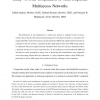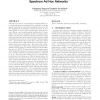5 search results - page 1 / 1 » Bursty relay networks in low-SNR regimes |
117
click to vote
TCOM
2010
14 years 11 months ago
2010
—In a wireless network, the use of cooperation among nodes can significantly improve capacity and robustness to fading. Node cooperation can take many forms, including relaying ...
107
click to vote
CORR
2006
Springer
15 years 24 days ago
2006
Springer
In this paper we look at the outage capacity of the fading relay channel with half-duplex constraint in the low SNR regime. First we consider the scenario that the channel state i...
92
Voted
CORR
2008
Springer
15 years 26 days ago
2008
Springer
The performance of user-cooperation in a multi-access network is compared to that of using a wireless relay. Using the total transmit and processing power consumed at all nodes as...
107
click to vote
CORR
2007
Springer
15 years 23 days ago
2007
Springer
— We consider a dense fading multi-user network with multiple active multi-antenna source-destination pair terminals communicating simultaneously through a large common set of K ...
162
Voted
MOBIHOC
2005
ACM
16 years 11 days ago
2005
ACM
This paper proposes a new principle for designing MAC protocols for spread spectrum based ad hoc networks ? inducing spatial clustering in contending transmitters/receivers. We fi...


